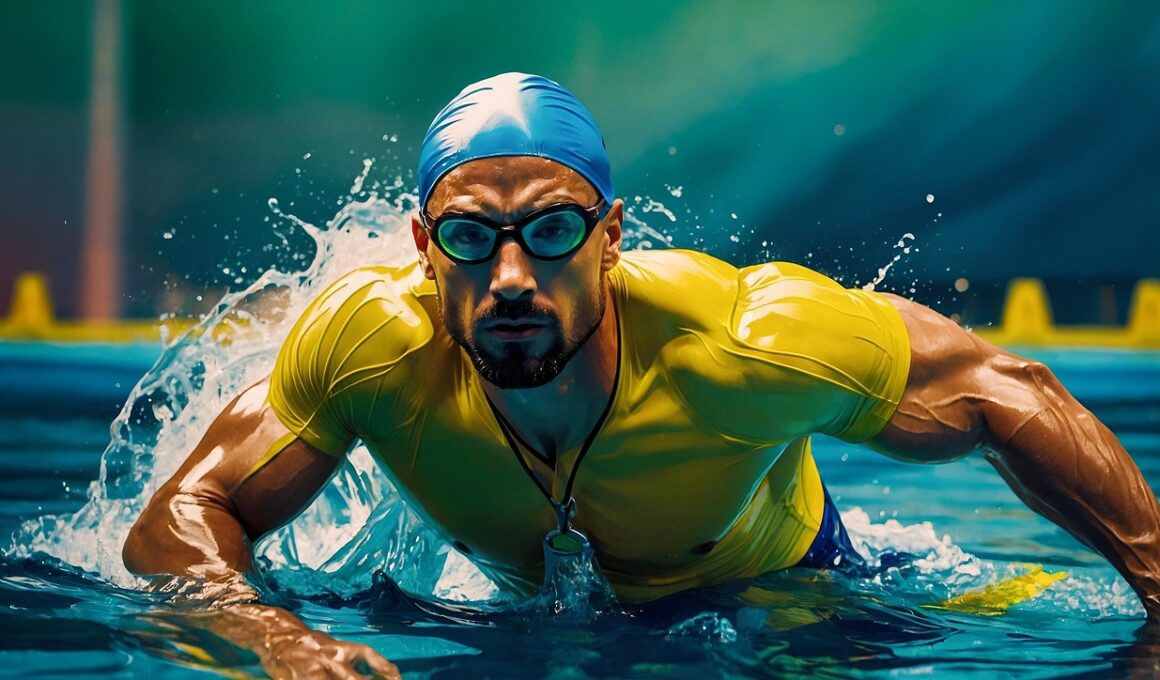How Relay Swimming Strategies Differ Across Swimming Strokes
Relay swimming offers a unique perspective on team dynamics, focusing on various techniques to optimize each swimmer’s contribution. It’s vital to understand that the distinct characteristics of different strokes necessitate tailored strategies for effective execution. For instance, in freestyle relays, speed and technique are paramount. Swimmers often concentrate on rapid starts and streamlined turns. Comparatively, the backstroke requires meticulous attention to the hand-off process. The entry timing can significantly affect momentum and efficiency in the water. Furthermore, breaststroke—often seen as the slowest stroke—demands a different pacing strategy to ensure good acceleration during the leg swim. Transitioning effectively from one swimmer to the next becomes crucial. Butterfly relay strategies emphasize powerful bursts, demanding that swimmers maintain stamina while delivering explosive speed. Notably, the coordination between teammates in these relays is essential. Establishing consistent pacing helps swimmers maintain energy levels, giving each swimmer the opportunity to thrive without burnout. Overall, developing effective relay swimming strategies fundamentally hinges on mastering the nuances of each stroke to align with team goals and individual strengths.
In relay events, how swimmers handle what is often referred to as the “touch” is of prime importance. This touch refers to the moment a swimmer makes contact with the wall to signal the next swimmer to start their leg. In freestyle, the technique allows for a nearly instantaneous transition, as swimmers can dive in almost from the wall. Conversely, backstroke transitions necessitate more careful coordination, as the outgoing swimmer cannot see the incoming swimmer. In the breaststroke and butterfly relay events, timing is even more critical, as improper touches can lead to disqualification. Meanwhile, the relay strategy also considers the order of swimmers. Each athlete’s strength dictates their placement in the lineup. A common practice is placing the fastest swimmer in the last position to anchor the relay. This tactic creates a final push for victory. Alongside this is the psychological aspect; the team’s morale can boost performance. Many coaches focus on building team cohesion to enhance trust during transitions. Ultimately, how a team customizes their strategy can significantly differentiate their performance in competitive environments.
Communication during a relay is a critical element that can determine success or failure. Effective dialogue among teammates ensures everyone is aware of the sequence and the start timing. Visualization and practice enhance this interaction; it fosters unity during races. In freestyle relays, visual signals are often employed, allowing swimmers to discern key timing information. For backstroke, the use of vocal cues is more common, as it provides swimmers with crucial prompts while they maintain their backstroke form. In breaststroke relays, swimmers must practice visually timing their entry in correlation with their teammate’s approach. An effective visual strategy can improve the swimmer’s diving technique into the water. When it comes to the butterfly stroke, it is essential that swimmers understand the importance of simultaneous momentum. Being aware of each other’s pace lessens the risk of miscommunication, improving their overall efficiency. Thus, communication is not just about words; it’s about fostering a non-verbal bond throughout the entire relay. Developing communication strategies can greatly enhance consistency and performance across various events, driving teams toward success.
Understanding Pace and Team Dynamics
In any relay swimming team, establishing a unified pace is essential. Each swimmer has unique capabilities, meaning team dynamics can vary significantly. For instance, in a medley relay, the different strokes can enhance certain swimmers’ natural abilities. Coaches analyze each swimmer’s performance in practice to develop optimal placement for each leg of the relay. One swimmer may excel in the fly, while another might thrive in breaststroke. Tailoring the order based on strengths maximizes team efficiency. In freestyle events, maintaining a high rhythm is critical to achieving a competitive time; this can be supported by incorporating specific interval training into practice. This training helps swimmers become accustomed to pacing alongside teammates. During transitions, maintaining pace helps reduce the likelihood of losing momentum. As momentum is vital, encouraging a strong finish becomes a top priority. Swimmer fatigue plays a role as well; if a teammate falters, it can set back the entire team. Thus, understanding pace not only considers individual ability but also how those abilities mesh to create a successful relay strategy.
Every relay swimming strategy is influenced by the type of race being undertaken. Typically, 4×100 and 4×200 freestyle relays are primarily focused on speed and power. Swimmers employ different breathing techniques and stroke intensities depending on the race distance. Shorter distances demand rapid bursts of energy, while longer distances emphasize endurance and pacing strategies. In contrast, medley relays showcase a mix of stroke techniques, allowing swimmers to leverage their strengths. Teams must practice how their swimmers can best complement each other during these mixed strokes. The butterfly leg often dictates the initial pacing due to its intensity, requiring swimmers to be prepared for the transition. Furthermore, managing rests is key; swimmers need to recharge between their respective leg strokes. Race strategies should thus emphasize recovery while ensuring athletes remain alert for upcoming transitions. Coaches often use video analysis to review past relays, identifying areas for improvement. This process also nurtures specific feedback tailored to each swimmer, focusing on their approach during the relay. Working on strategies like modifying strokes to intensify final sprint speeds can greatly influence relay success.
Analyzing Competition and Adapting Strategies
Adapting to opponents is essential in competitive swimming, especially during relays. Teams must study their competitors’ times and techniques to formulate a strategy effectively. Observing rival teams can present insight into potential weaknesses they can exploit. For instance, if a competitor struggles with transitions, focusing on speeding up the hand-off could be advantageous. Conversely, streamline techniques can be adopted from observing successful teams. Adaptability allows swimmers to fine-tune their approach for maximum efficiency while working to enhance overall performance. Swimmers must be sufficiently aware of both their own skills and those of their opponents. Record keeping also facilitates understanding past performances, allowing teams to track progress over time. Analyzing competitors fosters confidence in race-formulating decisions. Attention to detail pays off during critical moments of a race. Swimmers often visualize potential matchups based on previous experiences, preparing mentally for their duties. The psychological component of competition can’t be overlooked; having confidence in their strategy delivers swimmers peace of mind. This preparation is essential, ultimately allowing teams to outperform less adaptive competitors.
Finally, after understanding various strategies, teams must prioritize practice to optimize their relay potential. Effective practice allows swimmers to master their techniques and enhances their overall understanding of relay swimming. Continual practice of starts, turns, and transitions becomes vital for speed. Coaches play a key role during these sessions by analyzing performances closely and providing detailed feedback for each swimmer. Emphasis on consistency improves team synchronization, which directly influences relay outcomes. Simulations of competitive environments can help swimmers build competitive instincts, allowing them to perform confidently during actual races. While timing and technique remain crucial, developing emotional resilience during relays cannot be overstated. Teammates supporting one another both mentally and physically strengthens the entire group. A successful relay requires cultivating trust among team members. Furthermore, promoting a growth mindset aids athletes in recognizing that each competition is a learning opportunity. With these insights, teams can refine their approaches and increase their chances of successful relay swims. Overall, dedicating time to practice and adapt strategies ultimately closes the gap between potential and performance.


